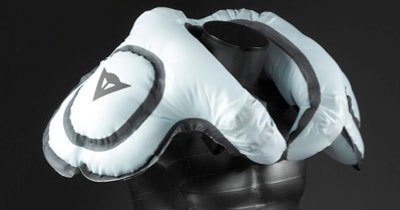Dainese D-air Racing Leathers Make U.S. Debut
Dainese has long been a purveyor of innovative safety equipment for riders, claiming the first knee sliders (1979), back protector (1981) and carbon/Kevlar knuckle protection (1995).
The Italian company makes another first in 2012, becoming the first manufacturer to offer airbag protection in an off-the-rack (or custom) leather racing suit in America, the D-air Racing, which it showed to the media earlier this week.
Building a functional airbag suit isn’t very difficult if a simple tether is used. Like a tethered kill switch on a snowmobile or PWC, an airbag can easily be triggered when a rider is detached from a motorcycle. But a tether has many disadvantages, not least of which is a rider simply dismounting his ride without switching off the airbag trigger. So Dainese (and Alpinestars, which is developing its own airbag suit) has come up with a complex set of sensors and electronics that can tell when a rider is in the midst of a crash.
To that end, the D-air Racing uses three accelerometers, three gyros and seven sensors to determine a crash is taking place based on 10-plus years of R&D, 5000 hours of data collection and more than 100 crashes. The electronics take just 15 milliseconds to make its calculation to trigger the bag in the event of a crash. It takes 30ms for 4 liters of air (“other companies use just 1 liter,” Dainese says, presumably A-stars) to inflate the air bladder that encompasses a rider’s shoulder areas, routed from a pressurized cylinder in the suit’s speed hump where the electronics are also housed. The entire package weighs just 650 grams.
Full protection, when air has forced its way throughout the entire airbag, is achieved in 85ms – that’s less than a tenth of a second from start to finish. These times aren’t just Dainese PR numbers; they’re certified by the German TÜV SÜD lab.
Independent testing reveals the bag reduces impact force to shoulders by 85% when compared to traditional body armor, also limiting excessive movement of the head. Dainese considers the motorcycle and rider as a single system and says it has 13 patents for D-air,. The triggering algorithm assesses the violence of the crash and won’t trigger at speeds below 30 mph or “when the crash dynamics don’t require the extra protection of an airbag.”
Unexpected deployment of the airbag, such as during violent headshake when it appears a crash is about to take place, doesn’t seem to be a problem for a rider. GP star Jorge Lorenzo began a wicked highside at Valencia in 2009, triggering the airbag, but he managed to gather things up and keep riding. It’s been reported the lap-time penalty was less than one second.
A GPS sensor is also part of the system, and this gives the D-air Racing system the ability to data-log your riding. The logger, made by 2D, which supplies data acquisition to MotoGP and F1 teams, records data while you ride, including lap times and vehicle speeds and is compatible with Google Earth to display your lines around a track.
AMA Superbike rider Blake Young was the first rider to use D-air in America during the last event of the 2011 AMA Superbike series at New Jersey Motorsports Park. After finishing off the box in Race 1, the Yoshimura Suzuki rider says he took some extra chances in the second race because he trusted the protection of the suit, consequently winning the race. “I was glad to be riding in the D-air suit,” he commented.
The D-air Racing suit, of course, includes all the safety and style benefits that have made Dainese one of the world’s premier leathers manufacturers. We’ve never been anything but very pleased whenever we’ve worn gear from Dainese.
All this technology and engineering doesn’t come cheap. The off-the-rack suit retails for $3999. A fully customized suit, including precise measurement and sponsor logos, sells for $4999. While that’s a hefty chunk of change, it’s relatively cheap when compared to shoulder surgery and the myriad costs of recovery time. An additional $220 nets two years of maintenance, which includes shipping. Orders will begin to be processed in June of this year.
Dainese also showed off new products in its 2012 line, some of which you can see in the photo gallery. For more info, check out Dainese.com.
More by Kevin Duke
































Comments
Join the conversation